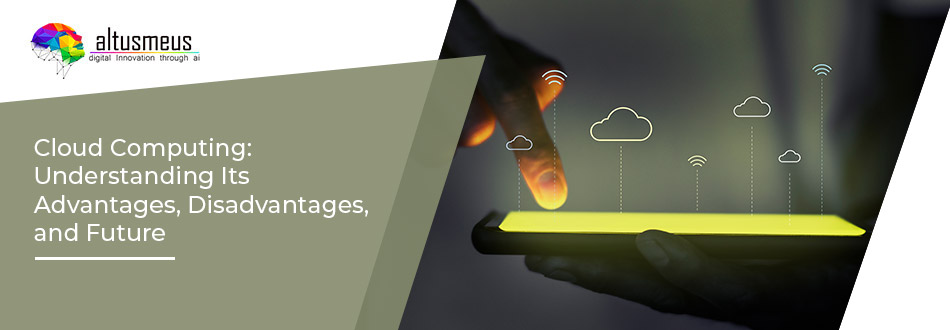In today’s world, most of the data is either stored or processed in the cloud. The term ‘cloud’ refers to a global network of interconnected servers that act as a massive hard drive, providing individuals and businesses with the ability to access their data from anywhere in the world. Cloud computing has become an essential part of our daily lives, yet many of us remain unaware of this fact. There are numerous examples of cloud computing that we use in our day-to-day lives, such as playing online games or storing and sharing files on Google Drive. Using apps such as Amazon for making purchases or reading your email on Outlook or watching popular shows on Netflix are also examples of cloud computing.
This technology has numerous benefits for both businesses and customers. As a business owner or customer, it is important to be aware of both the advantages and disadvantages of cloud computing before investing your money in it. However, before looking into the benefits and drawbacks of cloud computing, it is essential to gain a better understanding of what it is, how it works, and where it is headed.
What is cloud computing?
Cloud computing is a technology that enables businesses or individuals to access IT resources on demand via the internet. It involves using remote servers to store, manage, and process data, rather than relying solely on local devices. This approach eliminates the need for companies to purchase, maintain, and operate physical data centres and servers. Cloud service providers such as Amazon Web Services (AWS), Microsoft Azure, and Google Cloud Platform offer cloud services on an as-needed basis. Companies offer their cloud service on a Pay-As-You-Go (PAYG) or subscription pricing model, which allows users to pay only for the resources they use.
There are different kinds of clouds that can be classified into three categories:
1. Personal Cloud: A personal cloud is a cloud computing setup that caters to individuals or small groups of users or companies. Users of personal cloud host it on their hardware, like a personal computer or a small server. It is used primarily to store and access personal files, such as documents, photos, and music, from anywhere with internet access.
2. Public Cloud: A public cloud is a cloud computing setup that is hosted by a third-party service provider and available to the public over the internet. It provides IT resources, such as computing power, storage, and applications, to multiple users at once. Amazon Web Services (AWS), Microsoft Azure, and Google Cloud Platform are among the most popular public cloud platforms. Public clouds are generally preferred by all types of businesses because they offer a more cost-effective way to access IT services without requiring significant investments in IT infrastructure.
3. Hybrid Cloud: A hybrid cloud is a combination of both private and public cloud setups that allows businesses to leverage the benefits of both clouds to create a more flexible and scalable IT infrastructure. Private clouds can be used to store sensitive and critical business data, while less sensitive data can be stored on the public cloud. Hybrid clouds offer businesses greater control, a higher level of security, and flexibility in managing their IT resources.
Organizations of every type, size, and industry are leveraging the power of the cloud for a wide variety of use cases, such as data backup, disaster recovery, email, virtual desktops, software development and testing, big data analytics, and customer-facing web applications. For instance, healthcare companies are using the private cloud to provide more personalized treatment to patients, financial services companies are using it for real-time fraud detection and prevention, and video game makers are utilizing it to deliver games to millions of players worldwide. Cloud computing brings many benefits to businesses and individuals, which we will discuss later in this blog.
How does it work?
Public cloud service providers own multiple servers located in various continents and countries. This provides users of cloud services with the ability to access their data or applications from anywhere in the world via the internet. Unlike traditional computing, where data is stored on a local computer in an office or home and can only be accessed when physically present at the location, cloud computing stores data on remote servers that are accessible from any location with an internet connection. In contrast, in a private cloud, the servers are owned and maintained by the user of the cloud.
Where is cloud computing headed or what is its future?
Cloud computing is rapidly growing and evolving, revolutionizing the way we do everyday things such as streaming movies on Netflix or Amazon Prime, booking tickets, navigating with Google Maps, playing video games, using Google Sheets, and using various kinds of digital tools and software. With the emergence of technologies such as artificial intelligence, machine learning, big data analytics, and the Internet of Things (IoT) becoming an integral part of our daily lives, it’s safe to say that cloud computing will continue to be a major player. These technologies require fast data processing and storage capabilities, which cloud computing can deliver. Cloud computing is becoming increasingly popular among individuals and businesses, and its popularity and our dependence on it are set to increase more in the near future. This is because cloud platforms are fast, and data stored on them can be easily accessed from anywhere using different devices that have an internet connection.
Let us look into the advantages and disadvantages of cloud computing to gain a better understanding of this technology.
Advantages of Cloud Computing:
1. Cost-effective: Cloud computing is a cost-effective solution for businesses looking to increase their computing power or storage capacity. Investing in expensive hardware and software can be a significant financial burden for companies, especially when they do not utilize the full capacity of these resources. However, with cloud computing, businesses only pay for the resources they use, which eliminates the need for expensive hardware and reduces maintenance costs. This allows businesses to concentrate on their primary functions and allocate their resources more effectively.
2. Scalability: Cloud computing offers an efficient solution for businesses that need to scale up their IT resources. Traditional methods of scaling up involve investing heavily in IT hardware and software. And this can be expensive and challenging, especially when scaling up or scaling down frequently. However, with the cloud, businesses can easily increase or decrease their IT resources based on their needs, without worrying about unused capacity or the costs associated with scaling up or down in short periods of time. This scalability feature of cloud computing provides businesses with more flexibility and savings.
3. Accessibility: Cloud computing provides businesses and individuals with better accessibility to their data and applications. With data stored on remote servers, rather than on local hard drives, cloud computing offers greater flexibility in terms of accessing information. As long as a good internet connection is available, data and applications can be accessed from anywhere in the world. The enhanced accessibility provided by cloud computing offers users greater convenience and allows businesses to operate with increased efficiency.
4. Global reach: Cloud computing enables businesses to swiftly deploy their operations on a global scale, allowing them to establish a worldwide presence within minutes. This technology also empowers customers to access data from any location on the planet, as demonstrated by successful implementations of apps such as LibriVox Audio Books, which provides easy access to audiobooks from anywhere, and eFootball™, a football game developed by Konami that allows players from different parts of the world to engage in real-time football matches, even if they are physically located thousands of miles apart.
5. Better data recovery: Cloud computing offers superior data recovery options when compared to traditional computing. This is due to the fact that cloud computing allows data to be stored in multiple locations, reducing the risk of data loss resulting from hardware failure or other disasters. In contrast, traditional computing relies on storing all data in one hardware at a single location, leaving it vulnerable to complete loss in the event of hardware failure or accidents such as fire.
6. Security: Cloud computing stores your data on servers that are not necessarily known to you, and in order for someone to access your data, they must first pass through the robust security measures that are enforced by cloud computing companies. These measures and features provide protection against unauthorized access, theft, and other security threats for your data that are not present in traditional methods of computing.
Limitations of Cloud Computing:
1. The need for internet connectivity: Cloud computing relies entirely on the internet, which means that without an internet connection, you cannot access your data or run your applications. In the event of poor internet connectivity or no internet connectivity at all, businesses may encounter difficulties in smoothly carrying out their operations.
2. Sharing data outside of the organisation: In cloud computing, businesses and individuals share their critical data with companies that provide cloud services, which then store this data on random servers. However, this practice raises questions regarding the privacy and security of the data. As the data is online, it is possible for unauthorized individuals to gain access to it using credentials or for hackers to hack into the data, thereby raising privacy and security concerns when using cloud computing services.
3. Cloud Service Provider Policies: While using the cloud for business is a great idea, it is important to keep in mind that cloud service providers have their own policies and terms and conditions. If a business somehow violates these policies or the provider suspects that the business is breaking the law or their terms and conditions, they can immediately stop the cloud service. Such actions can have serious consequences for any business’s reputation and operation.
4. Regulatory actions from government agencies: Storing sensitive information, such as banking or medical, or defence-related information, on a third-party server is not a good idea. In some countries, government agencies can take legal action against companies that engage in this practice.
5. Downtime risk: In cloud computing, data is stored on servers owned by cloud service providers, and companies that use these services and store their data on these servers have limited control over them. If a technical issue occurs with the servers, the company may experience downtime, and their business operations may suffer as a result.
Conclusion
Cloud computing is a revolutionary technology that has changed the way we interact with digital services. From online gaming to big data analytics, cloud computing has brought many benefits to individuals and businesses alike. It offers cost-effective solutions, scalability, and increased accessibility to data and applications. As technology evolves, cloud computing is set to become even more crucial in delivering fast data processing and storage capabilities. However, before investing in cloud computing, it’s important to consider both its advantages and disadvantages.





